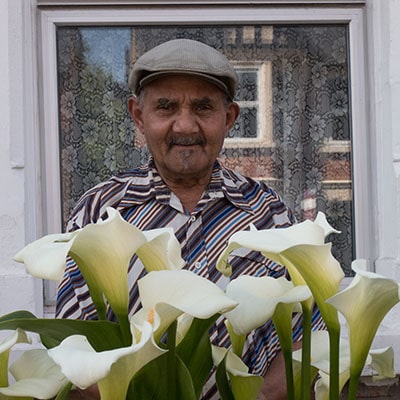Architecture and anarchy: another world is possible
Sometimes a chance experience draws you in to exploring an idea. This happened to me on my first visit to my elder daughter’s new home in Edinburgh. I thought I knew the city well, I lived there briefly in the early 1970s, but she has a wee flat in one of Edinburgh’s ‘colonies’, a distinctive housing phenomenon for over 160 years. Locals recognize them instantly with their imaginative design and build, the homes including gardens, kitchens and a front door, often up a steep flight of steps as in my daughters case, in contrast to the multi-storey living of the Old Town. Aimed at working class tenants generally in specific occupations or trades, my daughter’s was for railway workers, and is still bounded by railway lines. Their success and failures have recently been written up by Richard Rodger in his book Happy homes; Cooperation, Communities and the Edinburgh Colonies (2022).  Over 2,300 houses were built by the Edinburgh Co-operative Building Society on eleven different sites on the outskirts of Edinburgh and Leith, hence their nickname ‘The Colonies’, between 1861-1911. The Co-op has long gone but their spirit lives on in what are now quirky, largely car-free, boho neighborhoods.
Over 2,300 houses were built by the Edinburgh Co-operative Building Society on eleven different sites on the outskirts of Edinburgh and Leith, hence their nickname ‘The Colonies’, between 1861-1911. The Co-op has long gone but their spirit lives on in what are now quirky, largely car-free, boho neighborhoods.
It prompted thought on what Colin Ward wrote about so much, anarchy in action, the values of which are rooted in things we all do. Mutual aid, self-organization and voluntary association are the underlying principles of anarchism, and find expression in people’s innate desires to share time and space without expecting any financial remuneration, exemplified in allotments, children’s playgrounds, free festivals, holiday camps, and housing co-ops. So it was with some delight to come across Paul Dobraszczyk’s book Architecture and Anarchism: building without authority (2021). Here in one book is a whole world of alternative and intentional communities, artistic experiments, expressions of dissent, and speculations about the future. Utopias of the mind and utopia as method.
Dobraszczyk kicks off his book with a photo of the famous Headington Shark house installed by one of my neighbours, the late Bill Heine in 1986; his comment on the civilian casualties of American air raids on Libya by F111 squadrons based at nearby Upper Heyford. The shark precipitated a protracted planning battle which he eventually won – propaganda of the deed. The book goes on to illustrate through sixty other very diverse examples, anarchist values in action. They are grouped into eight categories; liberty, escape, necessity, protest, ecology, art, speculation and participation, and are drawn from across the global north, mainly, and the last fifty odd years, mainly. Taken together they significantly broaden existing ideas about what might constitute anarchism in architecture – to breaking point in some cases, but in doing so also argue strongly for its nurturing in the built environment. They point to anarchism offering a powerful way of reconceptualizing architecture as an emancipatory, inclusive, ecological and egalitarian practice.
Let’s turn to the anarchism before looking at the architecture. The importance of the bult environment in anarchist projects was recognized by late 19 century anarchist thinkers such as Elisee Reclus and Peter Kropotkin, who were also pioneers in the study of geography. Reclus in particular argued that it was only in cities that the full flowering of human diversity was possible. Kropotkin’s focus was on building networks of small scale autonomous communities drawn from the libertarian socialist society imagined in William Morris’s utopian novel News from Nowhere, published in 1890. Both of these strands were important influences on the radical town planning of Patrick Geddes, who stressed the importance of cities connectivity to their larger geographic regions and empowerment at a local level, in his Cities in Evolution (1915). But it was Colin Ward and his friend the American critic Paul Goodman who cemented the links between anarchism and architecture. Goodman’s 1947 book Communitas traced utopian visions of urban planning back to Morris and Geddes for American audiences, while Ward, in a huge range of books and pamphlets, most notably Anarchy in Action (1973) investigated a range of social practices that he regarded as anarchist, in housing, work and leisure, urban policy, architecture and design, not to mention everything from allotments to plotlands and how children perceive and engage with cities.
This sets the scene for Dobraszczyk. He argues that French sociologist Henri Lefebvre’s 1967 essay The right to the City (seen as prophetic of the 1968 uprisings in Paris and other cities) is on to something with his conceptualization of organization in cities, starting from the bottom up in the ‘holes and chasms’ of the city i.e. spaces and structures that escape the control of the city powers, one example being abandoned buildings. These are places where experimentation is possible, the ‘seeds beneath the snow’. Dobraszczyk remarks, ‘In recent years there’s been a focus on how DIY or ‘guerilla’ urbanism has taken advantage of such spaces precisely in order to experiment with alternative approaches, examples of which include…. the community urban gardens Agrocite in Paris, and Prinzessinnengarten in Berlin. But these might also be cooperative forms of housing, and business, community land trusts, self organized buying and selling; parkour, skateboarding, and urban exploration; reoccupied abandoned buildings; and the protest camps of the Occupy Movement and more recently Extinction Rebellion.’ Whether the creators of such experiments and initiatives would all consider themselves expressions of anarchist architecture is moot; reconceptualizing space, for sure, building without authority, only sometimes. However spreading the net so widely does give a frisson of excitement and danger to the broad range of initiates swept up in its architectural embrace.
There are so many gloriously wayward and inventive projects recorded in Architecture and Anarchism, that it is hard to know where to start, but as its chapter titles suggest, their waywardness is contained within a structure that provides coherence. Perhaps the best known, and one of the most long lasting examples of anarchist architecture is the one that the comes first in the case studies, Christiania in Copenhagen. Founded in 1971 when an abandoned army barracks was squatted, it is now home to around 1,000 residents in a self governing ‘free town’. Most live in the extensively converted barracks, but others have individual homes some ‘architect designed’, others self-built – ‘all architectural oddities’- in the grounds or on the adjacent lake. Other projects like Burning Man, the festival in Nevada, which attracts over 70,000 participants for a week in the desert ends with a complete clean up all evidence of habitation and is finally erased by winter dust storms. On a wholly different scale is India’s Kumbh Mela festival held every three years at different sacred riverside sites along the Ganges. The 55-day festival can accommodate up to five million devotees and up to 120 million visitors. It requires a level of planning and a timescale that could hardly be described as anarchist in the commonly understood sense of the term, but it is temporary, and the various religious groups who attend organize their own camps autonomously, using light weight low-tech materials that are easily erected and deconstructed. There is an echo of this in a site like Slab City in California, once a military camp now inhabited by a few hundred people except in the autumn when thousands of ‘snowbirds’ in their camper vans descend to enjoy the southern California sunshine before moving back home as the temperature rises in the spring. Whether Henry David Thoreau would have empathized with this lifestyle in the cabin which he built in 1845 at Walden Pond Massachusetts, we cannot know, but the romantic longing for a more direct relationship between humans and the natural world connects them, as it does the pioneers in England’s plotlands – families seeking to escape overcrowded cities by buying a tiny space on the coast to build their own slice of paradise. But such anarchic experiments are far from always expressions of escape or of faith. The barrios and favelas of great cities in the global south are expressions of self-build and self-organization often out of desperation, as city authorities either lack the resources or political will, and wash their hands of responsibility for their burgeoning populations. Refugee camps that over time become permanent are another example, and the Calais Jungle is cited as one of those built from necessity.
The domestic and the democratic aren’t ignored either, such as the Walter Segal inspired self-build homes in Lewisham, or the ‘Autonomous Terrace’ immortalized in Clifford Harper’s celebrated illustrations for the countercultural handbook Radical Technology (1976) published as a direct response to the Whole Earth Catalog, presenting various DIY technologies as tools to democratize design. In contrast to the high-tech wizardry of Buckminster Fuller, Stuart Brand and Drop City, Radical Technology presented a communitarian approach to design, very much a vision of subversion from within – the tactic that chimes with Colin Ward’s writings and the British tradition of a more gentle and quotidian form of anarchism. In a way it sums up the contradictions inherent in anarchism, the freedom-in-community promoted in the Autonomous Terrace, a concept taken up with much success by groups such as the Fireside Housing Co-op in Sheffield, which is starkly different from the individualized libertarianism of Brand and other American writers and practitioners. In foregrounding these examples, another is the work of Assemble in Liverpool, Dobraszczyk acknowledges that the social vision that anarchism presents is embedded in the local, in already existing pathways towards greater autonomy, where architecture is to be transformed from being a product, into a social process. He, Ward, Goodman (as well as Kropotkin, Morris and Geddes a century earlier) and all the people who have taken their ideas up and transformed them into the practical examples set out on the pages of Architecture and Anarchy, show in dozens of different ways that another world is possible.
This article first appeard in the July/August 2023 issue of Town and Country Planning.

